The best art supplies for stroke recovery therapy include ergonomic paintbrushes with right-angle handles, adjustable height easels, therapeutic modeling clay, adaptive drawing tablets, non-slip art tables, pre-formatted canvas boards, digital art therapy apps, tactile sensory art kits, watercolor sets with simplified color management, and touch-responsive sensory boards. These tools support hand strengthening, proper positioning, and motor skill development while making art therapy accessible and engaging. Discover how each option specifically targets different aspects of your recovery journey.
Ergonomic Paintbrushes With Enhanced Grip Features
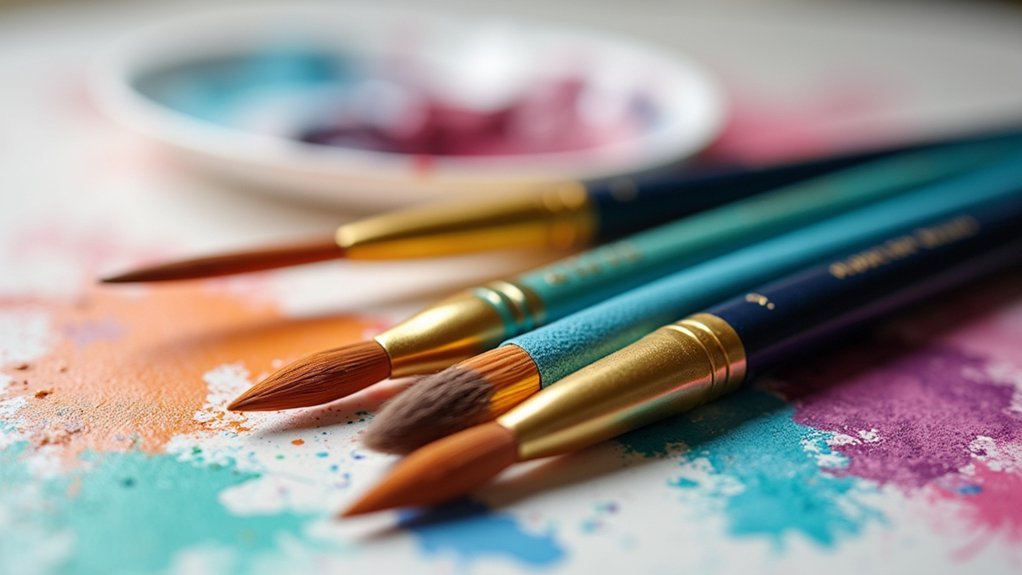
The right paintbrush can transform stroke recovery therapy from a frustrating exercise into a rewarding artistic experience.
Look for brushes with right-angle handles that promote neutral wrist positioning, allowing you to use stronger shoulder muscles instead of straining weakened hands. Specialized options with ergonomic design reduce wrist and hand strain while accommodating both left and right-handed users.
Soft-touch, anti-slip surfaces greatly improve grip security during painting sessions. Larger-diameter handles with cushioning materials accommodate reduced hand strength while textured or ridged surfaces prevent slipping when grip is compromised.
For maximum comfort, choose brushes with beech wood handles shaped to reduce fatigue.
Consider brushes with high-quality polyester-nylon bristles that require less pressure to paint effectively.
These quality bristles promote smoother stroke execution with minimal effort—important when you’re working to rebuild motor skills through consistent, comfortable practice.
Adjustable Height Easels for Seated or Standing Art Sessions
Adjustable height easels offer you essential flexibility during stroke recovery, with easy-to-operate mechanisms that accommodate both seated and standing positions.
Wheelchair accessible designs guarantee these easels can be positioned at the ideal height and angle for your comfort, regardless of mobility limitations.
Look for models with stability features like weight bags and screw leg clamps that create a secure, wobble-free platform for your therapeutic art sessions. The ergonomically designed options provide an optimal workspace environment that reduces strain during your recovery exercises.
Easy Height Adjustment Mechanisms
For stroke patients maneuvering their recovery journey, height-adjustable easels offer essential flexibility that adapts to changing physical abilities and therapy needs.
Various mechanisms make adjustments effortless, even with limited dexterity. Rack and pinion systems provide smooth, controlled movement, while telescoping legs with locking mechanisms accommodate both seated and standing positions.
Screw leg clamps on tripod-style easels offer quick adjustments and compact storage. The Access Easel provides screw leg clamps that enable therapists and patients to set up quickly and transition between positions with minimal effort. Some advanced models feature motorized height adjustments with limit switches for safety.
Look for easels with sliding canvas holders that move independently of the base height, optimizing ergonomic positioning.
The Access Easel by Artristic and Rehabmart models are excellent options, featuring lightweight materials, wide adjustment ranges, and stability enhancements like weight bags to prevent tipping during therapy sessions.
Wheelchair Accessible Designs
Designed specifically with mobility challenges in mind, wheelchair accessible easels represent a critical advancement in art therapy equipment for stroke recovery patients.
These specialized easels feature tripod configurations that accommodate wheelchairs while maintaining stability through weight bags as counterbalances. The Mabef Painting Workstation Easel M-30 is particularly effective with its integrated workstation design that enables comfortable painting sessions for wheelchair users.
You’ll find these designs particularly beneficial during your recovery journey:
- 360° canvas rotation allows you to reach all areas without repositioning yourself or your wheelchair.
- Adjustable angles from fully vertical to horizontal accommodate your specific comfort needs and physical limitations.
- ADA-compliant dimensions guarantee proper heights and clearances for wheelchair users of all ages.
The ergonomic panhead design reduces strain on hands with limited dexterity, while customizable positioning supports the varied therapeutic approaches essential for regaining motor control during stroke recovery.
Stability Features Matter
Stability serves as the foundation for effective art therapy during stroke recovery, complementing the wheelchair accessibility features previously discussed. When selecting an easel, you’ll want adjustable height options that accommodate both seated and standing positions as abilities progress. The TherAdapt Adjustable Angle Easel offers angle adjustability ranging from 40° to 70°, making it suitable for various art activities as recovery progresses.
| Feature | Benefit | Therapeutic Value |
|---|---|---|
| Tripod Design | Enhanced balance | Prevents frustrating accidents |
| Screw Leg Clamps | Quick setup | Conserves energy for art |
| Weight Capacity | Supports various materials | Expands creative possibilities |
Look for easels with customizable settings that adapt to changing needs. These stability features aren’t just about safety—they directly impact therapeutic outcomes by promoting proper posture, reducing strain, and creating an environment where focus can shift from physical limitations to creative expression. The right easel becomes an ally in rebuilding confidence and motor skills.
Therapeutic Modeling Clay for Hand Strengthening
Therapeutic modeling clay stands as a cornerstone in stroke recovery therapy, offering substantial benefits for patients working to regain hand strength and dexterity. The tactile nature of clay provides essential sensory input while simultaneously building muscle strength in fingers and hands—a vital combination for neurological recovery. The benefits of this artistic medium directly contribute to neuroplasticity development, which is essential for restoring functions impacted by stroke.
You’ll find clay particularly effective because it:
- Engages multiple systems – Combines motor skill development with cognitive stimulation and emotional expression
- Adapts to your progress – Can be adjusted in firmness to match your current strength level
- Motivates continued practice – Creates tangible results that boost self-esteem and encourage persistence
Unlike passive exercises, clay manipulation actively engages you in your recovery, making therapy sessions more meaningful and effective while promoting essential hand-eye coordination.
Adaptive Drawing Tablets With Touch Sensitivity Controls
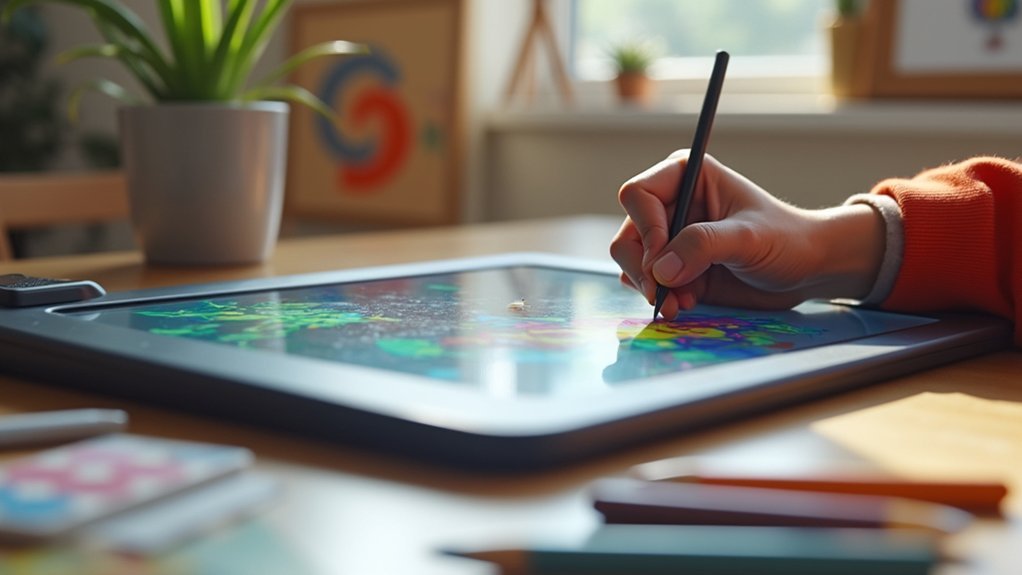
Adaptive drawing tablets with touch sensitivity controls represent a technological breakthrough in stroke recovery therapy, offering patients digital alternatives that complement traditional tools like modeling clay. These devices enhance neuroplasticity while reducing stress during rehabilitation.
You’ll find these tablets particularly beneficial for communication if you’re dealing with aphasia or limited dexterity. They’re customizable to your specific needs and abilities. Many tablets feature word prediction software that can significantly improve writing efforts during therapeutic sessions.
| Feature | Benefit | Application |
|---|---|---|
| Adjustable sensitivity | Accommodates limited mobility | Hand coordination exercises |
| Customizable interface | Adapts to cognitive abilities | Memory and attention training |
| Portable design | Use anywhere, anytime | Consistent therapy continuation |
The intuitive touch interface makes these tablets easy to master regardless of your cognitive function level. They’re cost-effective compared to traditional art supplies and environmentally friendly, eliminating waste while maximizing therapeutic outcomes.
Non-Slip Art Tables With Material Securing Options
When recovering from a stroke, you’ll find non-slip art tables with material securing options essential for successful therapy sessions.
These specialized surfaces prevent frustrating slips and shifts while you’re creating, allowing you to focus entirely on your artistic expression rather than struggling with unstable materials. Art therapy serves as an excellent complement to physical therapy techniques that focus on relearning movements and improving coordination after stroke.
Look for tables that offer:
- Ergonomic design with adjustable heights to accommodate your specific mobility needs
- Integrated securing systems like clamps, magnetic frames, or adhesive strips to keep materials firmly in place
- Durable, easy-to-clean surfaces made from rubber or silicone that provide stability for your supplies
The enhanced stability these tables provide reduces frustration and improves focus, making your art therapy sessions more productive and enjoyable while supporting both physical coordination and cognitive rehabilitation.
Easy-Grip Sculpting Tools With Comfort Handles
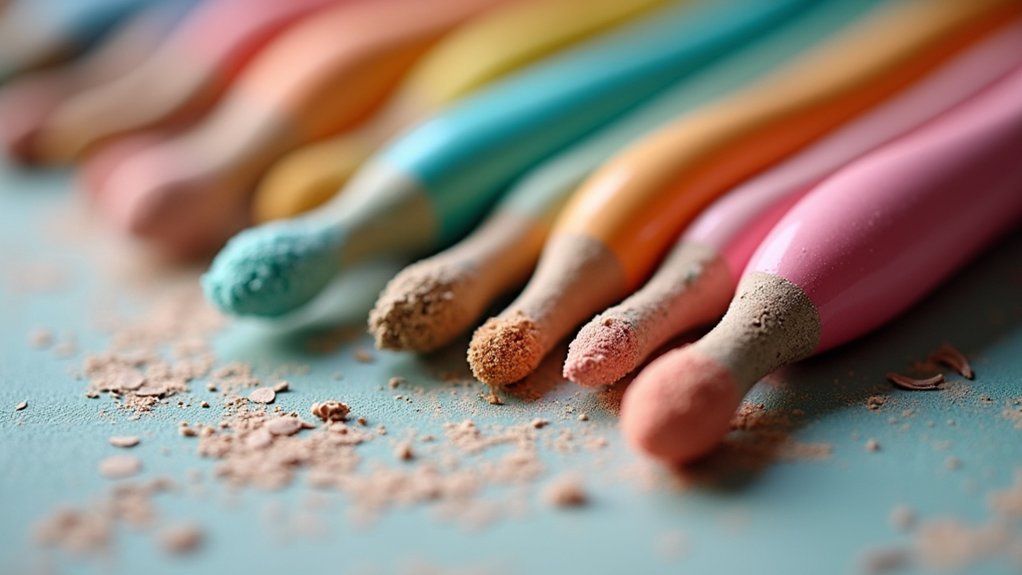
Easy-grip sculpting tools with comfort handles represent a breakthrough in stroke recovery art therapy. These tools feature contoured shapes with soft, non-slip materials specifically designed for weakened or partially paralyzed hands.
You’ll appreciate how the lightweight construction with foam or gel padding reduces joint pressure while providing tactile comfort during extended therapy sessions. The ergonomic grips promote proper hand positioning, encouraging improved motor patterns rather than compensatory movements.
Many tools offer adjustable or interchangeable handles that can be customized to your specific needs, with some compatible with adaptive gloves for additional support. These tools harness the principle of neuroplastic rewiring through consistent, focused practice.
Personalize your therapy experience with adjustable handles that work seamlessly with adaptive gloves for maximum support and comfort.
As you work with clay or putty, these tools facilitate fine motor skill development through controlled manipulation, providing essential sensory feedback for improved coordination. Their affordability and availability through rehab suppliers make them accessible for home therapy programs.
Pre-Formatted Canvas Boards With Stability Features
Pre-formatted canvas boards with stability features provide essential support for stroke survivors engaging in art therapy.
These specialized boards include non-slip backing, adjustable legs for uneven surfaces, and secure locking mechanisms to keep artwork stable during creation—crucial benefits for those experiencing limited dexterity or cognitive challenges.
You’ll find these therapeutic tools particularly valuable for their:
- Adaptability – Available in various sizes with textured surfaces to enhance tactile experiences and attached handles for easier positioning
- Convenience – Removable inserts facilitate cleanup while pre-drilled holes accommodate additional support materials
- Integration benefits – Track progress over time while building self-esteem through multidisciplinary rehabilitation programs
These boards reduce frustration by minimizing spills and providing setup ease, allowing you to focus on the therapeutic benefits of artistic expression rather than logistical challenges. The transition from using the right hand to drawing with the left hand, as seen in Sean’s journey, demonstrates the importance of having stable art surfaces during the rehabilitation process.
Digital Art Therapy Applications for Progressive Motor Skills
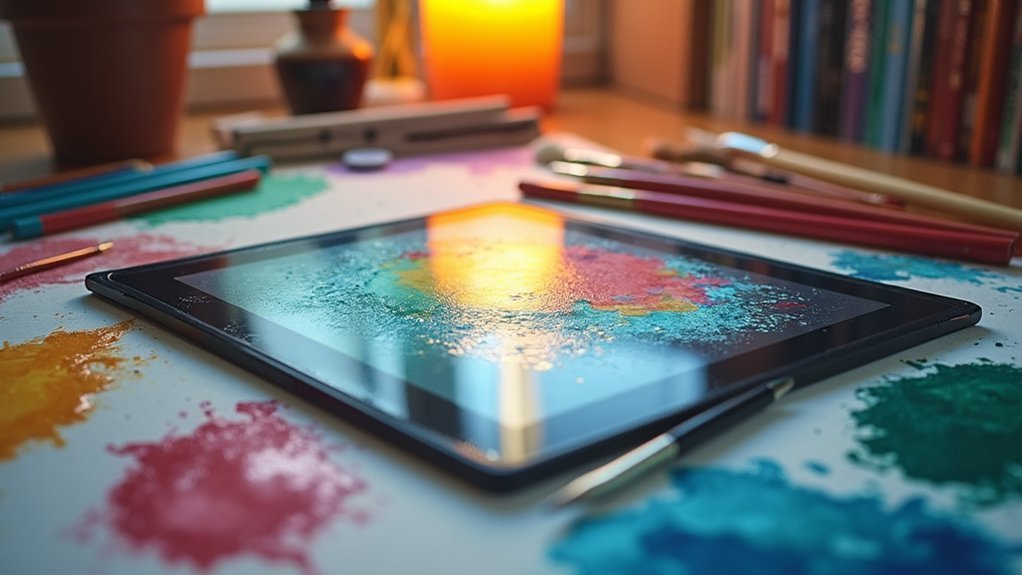
Digital art therapy applications have revolutionized stroke rehabilitation by combining technological innovation with creative expression to develop progressive motor skills. You’ll find these platforms particularly beneficial as they allow customization based on your specific recovery needs while tracking progress digitally. Visual arts therapy approaches including digital art have been shown to be highly effective for improving psychological responses in stroke survivors.
| Platform Type | Benefits | Best For |
|---|---|---|
| Tablet Drawing Apps | Accessibility, precise finger control | Early recovery stages |
| VR Art Studios | Immersive experience, 3D movement | Advanced motor rehabilitation |
| Motion-Tracking Software | Real-time feedback, data analysis | Measuring improvement metrics |
Virtual reality integration offers immersive environments that enhance engagement through the “Michelangelo Effect,” stimulating brain regions responsible for motor control. Studies confirm faster recovery rates with digital art therapy compared to traditional methods, with significant improvements in upper limb functionality. These applications work exceptionally well in home-based settings, making therapy more accessible regardless of mobility limitations.
Tactile Sensory Art Kits With Varied Textures
Tactile sensory art kits offer stroke survivors a powerful way to reconnect with their sense of touch through carefully designed multi-texture exploration materials.
You’ll find these kits equipped with diverse elements like textured fabrics, clay, finger paints, and sand that stimulate different sensory pathways while supporting motor skill recovery.
Touch-responsive sensory boards complement these materials by providing consistent tactile feedback and measurable progress as you work to regain dexterity and sensory perception during rehabilitation. These therapeutic art supplies can be integrated with interactive technology that enhances cognitive rehabilitation while making tactile exercises more engaging for patients.
Multi-Texture Exploration Kits
Sensory awakening begins with touch—a fundamental ability often compromised after a stroke. Multi-texture exploration kits offer diverse tactile experiences to rebuild sensory pathways through deliberate practice.
These portable collections combine natural materials like wood and fabric with synthetic textures to stimulate neuroplasticity and enhance fine motor skills. Patients can utilize over 50 activities developed by certified occupational therapy professionals to address specific rehabilitation needs.
Your therapy journey can include these effective exploration activities:
- Texture hunting – Search for objects hidden in rice or sand, encouraging blind identification
- Temperature differentiation – Practice distinguishing between hot and cold materials to restore temperature sensitivity
- Touch localization – Engage in exercises that help you accurately identify where touch occurs on your body
These customizable activities build confidence while improving cognitive functions like memory and problem-solving—essential companions on your recovery path.
Touch-Responsive Sensory Boards
While multi-texture exploration kits offer portable sensory experiences, touch-responsive sensory boards take tactile rehabilitation to another level by providing fixed, organized surfaces for structured therapy.
These interactive boards feature various textures like fabric, foam, wood, and sandpaper specifically designed to re-educate sensory pathways after stroke.
You’ll find these boards particularly effective for improving touch sensitivity, enhancing fine motor skills, and supporting cognitive recovery. Many include buttons or touch-sensitive elements that provide immediate feedback, encouraging active participation in your rehabilitation journey.
When integrated with occupational therapy, these boards become powerful tools for sensory re-education. These should be used for short periods in quiet environments to maximize their effectiveness and prevent sensory overload. They’re adaptable to different ability levels and can complement other therapies like physical rehabilitation and cognitive stimulation programs.
Their user-friendly design guarantees accessibility regardless of your current mobility limitations.
Watercolor Sets With Simplified Color Management Systems
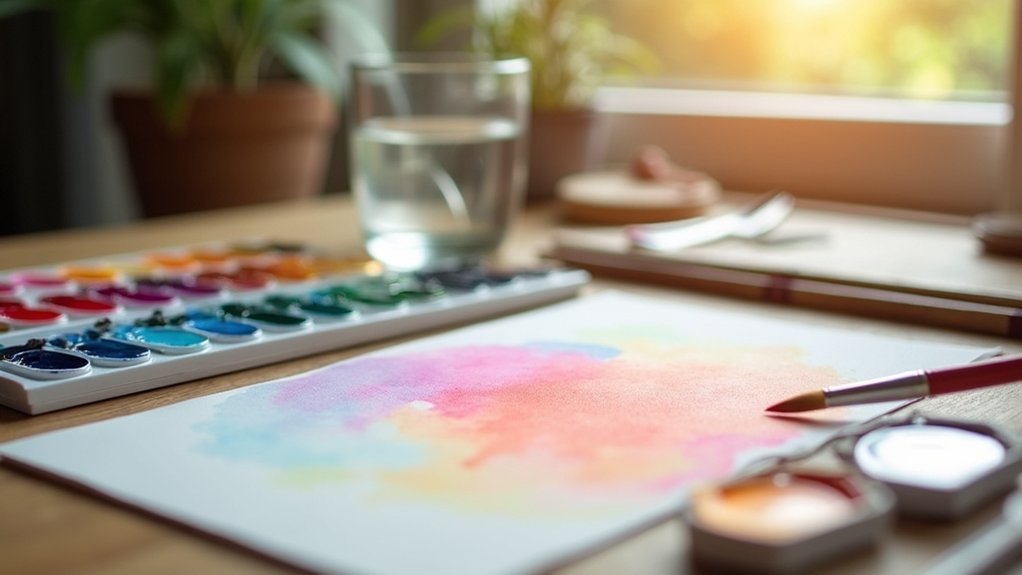
Many stroke recovery patients benefit from watercolor sets that feature streamlined color management systems. Sets like School Smart’s 8-color pan provide a manageable color range while being non-toxic and washable—ideal features for therapy settings where simplicity and safety matter most.
These watercolor sets support recovery by:
- Providing a calming, stress-relieving activity that promotes emotional well-being
- Encouraging fine motor skill development through brush handling and color mixing
- Offering adaptive options for various ability levels, making art therapy accessible
The built-in mixing palettes and organized color layouts simplify decision-making, an important consideration for cognitive rehabilitation.
When paired with digital tools like Watercolor Studio, patients can even enhance their artistic experience while working within their therapeutic boundaries.
The Van Gogh Pocket Set, with its higher color vibrancy and excellent blending properties, offers an excellent option for patients who are ready to progress to more expressive artistic work.
Frequently Asked Questions
How Soon After Stroke Can Art Therapy Safely Begin?
You can begin art therapy once you’re medically stable, typically within weeks to months after your stroke. Your doctor will assess your readiness based on essential signs, cognitive function, and energy levels for safe participation.
Are Art Supplies Covered by Insurance or Medicare?
Art supplies typically aren’t covered by insurance or Medicare. You’ll usually pay out-of-pocket, though therapy sessions might be covered when administered by licensed professionals. Consider FSAs or HSAs for tax-free purchases when prescribed.
How Can Caregivers Effectively Participate in Art Therapy Sessions?
You can join the art sessions, provide encouragement, model positive behaviors, and learn alongside your loved one. Don’t forget to engage in peer support for your own stress relief and mental health.
What Art Activities Help With Speech and Communication Recovery?
For speech and communication recovery, try sequential storytelling, collage-making with labeled objects, guided drawing prompts, art journaling, and music-integrated art tasks. These activities stimulate language centers, bypass damaged pathways, and reduce communication anxiety.
How Long Should Daily Art Therapy Sessions Last for Effectiveness?
For ideal effectiveness, you’ll find one-hour art therapy sessions most beneficial. Aim for three sessions weekly, but don’t push beyond your comfort level. Regular engagement matters more than length—adapt based on your fatigue and progress.
In Summary
You’ve now discovered valuable art supplies that can make your stroke recovery journey more effective and enjoyable. Whether you’re working on fine motor skills with ergonomic brushes or building strength with therapeutic clay, these tools offer both rehabilitation benefits and creative expression. Remember to start slowly, be patient with yourself, and celebrate small victories. Art therapy isn’t just about recovery—it’s about rediscovering joy through creativity during your healing process.

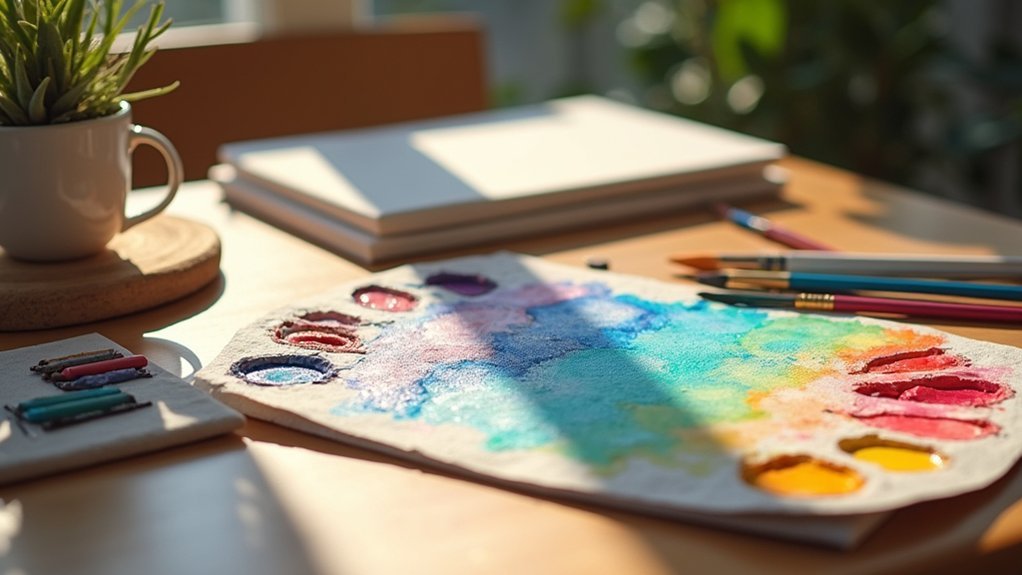



Leave a Reply